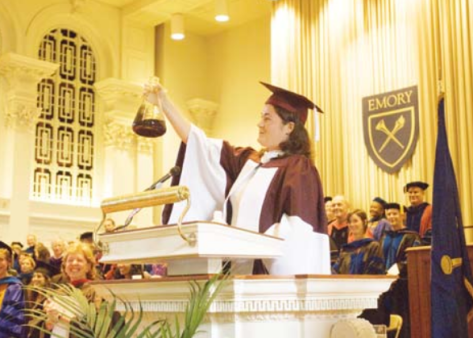When last we heard of the Emory Alma Mater in this space, it had been sung at Commencement in 1977 and then ignored during the presidency of Jim Laney, who thought it was too hackneyed for a great university.
In 1990, at the urging of then-Secretary of the University Tom Bertrand, Laney tried to persuade the Emory poet and medical professor John Stone to pen a new Alma Mater. Laney even pointed to possible composers on the faculty, including Carlton “Sam” Young, who edited two Methodist hymnals, and Don Saliers, a gifted musician in his own right as well as father of Indigo Girl Emily Saliers 85C. A well-regarded poet (who would later turn out a splendid commissioned poem for the inauguration of President Jim Wagner, in 2004), Stone either declined or failed to produce the desired new work.

So the song lay dormant for a time, sung occasionally at alumni gatherings but not by students, who largely were unaware of it.
Enter Jason Hardy 95C. With a voice that would carry him to musical theater and opera after graduation, Hardy the undergraduate gathered around him some other talented male singers and founded Emory’s first a cappella singing group, No Strings Attached. They performed together for the first time in 1994. Looking for a possible signature song, Jason dug into Emory’s choral music library and found something surprising. Emory had an alma mater!
By that time I was serving as secretary of the university, and Jason approached me about his find. Would there be any objection to the group singing it? Was there a problem with “Dixie”?
In those days the campus staff and faculty newspaper, Emory Report, published a weekly informal readers’ poll, so I suggested that the editor pose the question to the campus.

With indifference from some, tacit permission from many, and objections by a few, Jason and I changed “In the heart of dear old Dixie” to “In the heart of dear old Emory,” and the words have remained that way ever since. No Strings Attached created its own crowd-pleasing arrangement with an upbeat and syncopated second verse featuring a tenor wail on the lines “crowned with love and cheer” and “We will ever sing thy praises.”
In 1999 we incorporated the Alma Mater–along with a bit of magic–into the opening convocation for first-year students. It turned out that for years, Ron Johnson, now professor emeritus of chemistry, had been demonstrating a cool chemical reaction while singing the Alma Mater to his classes. As he began the last line, he’d mix two clear liquids into a large beaker. Just as he hit the phrase “Hail the Gold . . . ” the mixture would turn bright yellow, and then suddenly, as he sang “and Blue,” pop!—the gold turned to blue!
We’ve presented that trick to the freshmen every year since.

In 2005 our chief Commencement planner, Michael Kloss, executive director of the Office of University Events, suggested reintroducing the Alma Mater to the Commencement ceremony. And there it remains–probably forever.

Gary Hauk



 Further correspondence ensued, and by 1981 the suggested changes had made their way to the University Committee on Academic Ceremonies. This august body was chaired by medieval historian George Peddy Cuttino, Oxonian, who, before retiring in 1984, left an indelible stamp on the ceremonies and heraldry of Emory. His committee rejected the proposed changes.
Further correspondence ensued, and by 1981 the suggested changes had made their way to the University Committee on Academic Ceremonies. This august body was chaired by medieval historian George Peddy Cuttino, Oxonian, who, before retiring in 1984, left an indelible stamp on the ceremonies and heraldry of Emory. His committee rejected the proposed changes.
